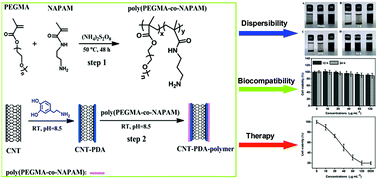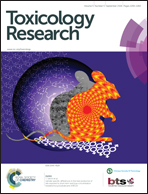Mussel-inspired PEGylated carbon nanotubes: biocompatibility evaluation and drug delivery applications†
Abstract
Carbon nanotubes (CNTs) have been widely examined for biomedical applications. However, surface functionalization of CNTs with polymers is often required to improve their application performance. To obtain these CNT-based polymer nanocomposites, surface-initiated polymerization strategies are generally adopted. However, all of these methods rely on the surface oxidation of CNTs, which is a rather complex and time-consuming procedure, and involves hazardous reagents. In this work, a facile and efficient bio-inspired strategy was developed for surface PEGylation of CNTs via a combination of mussel-inspired chemistry and the Michael addition reaction. The potential biomedical applications of these PEGylated CNTs were evaluated for intracellular delivery of a normally used anticancer drug (Doxorubicin hydrochloride). Two steps were involved in this strategy, which included the surface coating of CNTs with polydopamine (PDA) through self-polymerization of dopamine, and a Michael addition reaction between the PDA-coated CNTs (CNT-PDA) and amino-functionalized polymers, which were obtained by free radical polymerization using poly(ethylene glycol) methyl methacrylate and N-(3-aminopropyl) methacrylamide as monomers. Results suggested that these PEGylated CNTs are well dispersed in aqueous solution and showed improved biocompatibility toward cancer cells. On the other hand, we also demonstrated that DOX can be effectively loaded on these PEGylated CNTs and delivered into cells for cancer treatment. More importantly, this strategy can also be utilized for surface modification of many other materials with different polymers due to the strong and universal adhesion of PDA and designability of polymerization. Therefore, this method should be of great interest for the fabrication of multifunctional nanocomposites for biomedical applications.


 Please wait while we load your content...
Please wait while we load your content...